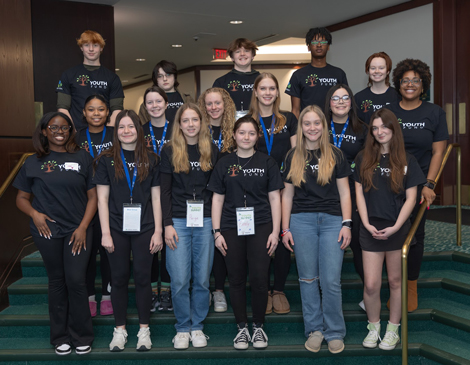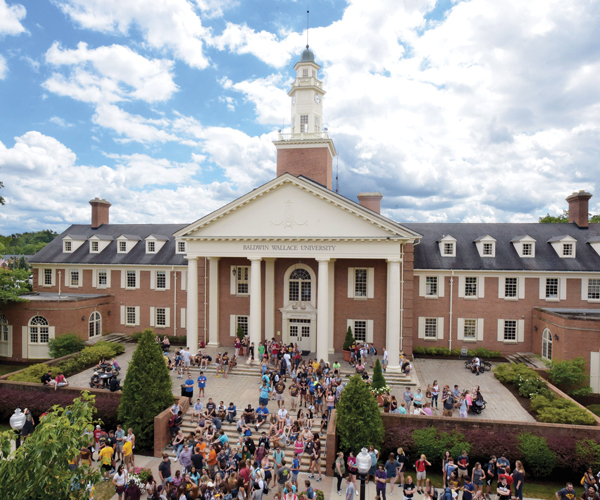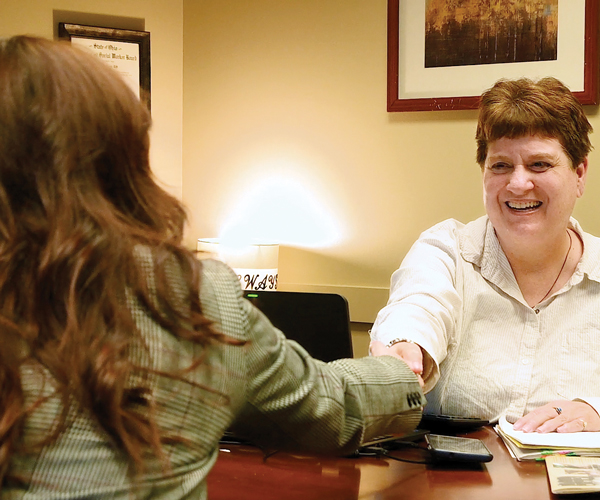When Cleveland Hearing & Speech Center staged a grand opening at its new MidTown Cleveland headquarters, there was no black tie, red carpet or passing around canapes and bubbly. Instead, the grounds were alive with a bounce house for neighborhood children pouring with waves of squealing laughter. Fare included balloon twisting, cotton candy and guided tours of the milestone-making facility.
It was a whole different kind of gala — and that was the point.
“I didn’t know you were here. I have to tell my daughter so my grandbaby can get help with her speech,” said a guest to Dr. Jennell Vick, president and CEO.
“Our mission has always been to provide inclusive, high-quality speech therapy, audiology and deaf services to all individuals, regardless of their background or circumstances,” Vick relates, noting one of the center’s initiatives, Project ELLA (Early Language and Literacy for All). “Cleveland is a city with chronic intergenerational poverty, and part of our role in helping to create economic mobility is to help the youngest members of our city develop the language skills they need that lead to literacy.”
Now the center has a presence and welcome mat to meet those needs where they are.
Cleveland Hearing & Speech Center’s move to MidTown falls on the heels of the Cleveland Foundation’s symbolic, fundamental move in spring 2023 to connect to the core and reimagine the Hough neighborhood and MidTown as its new headquarters.
“We are changing the narrative on a national level about how philanthropy has felt behind the curtain or inaccessible, and we have started a movement around the country by demonstrating how community foundations can open their doors, make a bigger tent, pull back the onion of philanthropy and make people feel a part of it,” says Lillian Kuri, Cleveland Foundation’s president and CEO.
Rooted in the Community
Across the country, other community foundations have been watching how this redirect from office cubicles to rooting right into the neighborhoods they serve is changing what philanthropy looks like and who engages. It also aligns with another transformation in giving: social impact. “The exciting thing I’ve noticed in the past few years is that people are much more interested in investing in solutions to problems of society,” says Vick, relating that a fresh generation of donors is mission-focused, centered on inclusion and desires to be stewards of change.
The collective experience of traveling a journey of change during the pandemic interspersed with “massive societal issues,” Vick says, pointing to political unrest, climate change and our increasingly global communities, has put “a magnifying glass on what really matters.”
There are multiple pressure points in play.
“Philanthropy is rapidly changing for a few reasons,” says Kuri, leading with the foundation’s decision as a place-based organization to show up exactly where the need is.
“Our new building has caused us to ask, ‘What does the community foundation of the future need to be?’ and it ties to the data,” Kuri says. “We know that more people are giving in smaller amounts to causes directly — most donations come from individuals. This is powerful because we were founded with the idea of harnessing individual giving for collective impact.”
Kuri says the philanthropic field is being disrupted by how and why people give.
Take crowd-funding platforms and viral social media campaigns that win one-off donations. “We are seeing an enormous amount of digital giving — people who want to get a text or go through social media,” says Debbie Rodriguez, chief development and marketing officer, Achievement Centers for Children.
“Also, we see the retention of individual donors has decreased, and we work very hard as an organization to make sure our fundraising initiatives are about relationships, not a transaction,” Rodriguez adds, noting that donors’ craving for making a social impact has elevated tremendously in the last couple of years.
“Younger donors want to give to causes, not necessarily organizations,” Rodriguez says. “They want to get involved with human rights, equity and inclusion, climate change, mental health — things that are fundamental to the work we do.”
So organizations have to tell their stories in meaningful ways that resonate with a desire to make a measurable difference.
Kuri points to the Cleveland Foundation’s three newly launched Affinity Funds and to expanded social impact investing. In six years, the foundation has grown the social impact investing from $50 million to $750 million.
“Everyone is familiar with the three Ts of philanthropy: time, talent and treasure,” adds Mary Wilson Wheelock, chief advancement officer at OhioGuidestone, the largest community-based behavioral health organization in the state. “But there are really six Ts, including ties, testimony and trust.”
Organizations are hearing those additional Ts loud and clear from longtime donors and an emerging generation of those giving back. They want to realize a connection, learn how their time and treasure helped initiate change and trust that gifts are stewarded with utmost responsibility and transparency.
Regarding trust, Wheelock emphasizes this as a necessity for garnering unrestricted gifts that allow organizations to filter funds where the need is greatest, which is always a variable.
Reporting is essential. She adds, “People want to know how their money helped.”
At Cleveland Public Library (CPL), Dr. Shenise Johnson Thomas and her team are showcasing how CPL enriches lives in the Cleveland community daily. Thomas wants the community to know that a library is more than books — it’s a hub for connection, curiosity and community building. It offers resources on critical issues like food security and technology access. She highlights that many nontraditional library services are funded through philanthropy, not tax dollars.
“We have a responsibility to tell donors how their dollars are being spent, and one of the best ways to do that is for recipients of the funds to tell their story,” says Thomas, chief of external relations and development for CPL.
For example, through a partnership with the Greater Cleveland Food Bank, CPL hosts a monthly food pantry. “A patron was able to get a coffee cake, and she informed the branch manager that she was so grateful for this because she could not afford to buy her child a birthday cake,” Thomas shares.
Regarding partnerships, this is another vital and sustaining effort for nonprofits across the region and country, Thomas says.
The CPL Foundation is asking, “How can we collaborate with different partners to bring more resources to bear for our community, or how can we combine our resources to go after philanthropic support together?” Thomas asks.
Dollars are finite. Time is limited. Resources are thoughtfully expended.
“Collaboration and coordination are essential,” Thomas says.
Deaconess Foundation’s President and CEO Cathy Belk says, “Partnership is required.” She adds, “The transformational change we seek requires everyone to work together and being at least complementary if not aligned and focused on the same outcomes, and working together to do that. We’ve never had so much alignment across the boar as we do now. I’m really encouraged by that.”
Driving Social Impact
Every dollar counts, and most of those come from individual donations.
At the Cleveland Museum of Natural History, 70% of gifts are from individuals, and the majority of those are less than $100. Specifically, of the 1,500 average gifts per year to the museum, 1,200 fall into this category. “That’s the bread and butter,” says Julia Ross, senior director of philanthropy and external relations. “It’s the continuous giving and recognizing that every dollar matters to the organization and is important to our mission.”
Those dollars together with generous gifts helped contribute to a monumental transformation project for the museum. “Without the endless support of our philanthropic community and our donors, we could not operate this museum or complete a project of this scale,” Ross adds.
Rodriguez notes the same giving patterns at Achievement Centers, reiterating Kuri’s remark about appreciating the generosity of every donor across the diverse giving landscape. At Achievement Centers, a substantial number of gifts are less than $500, and 25% of the agency’s budget comes from contributions.
Consistency is what nonprofits hope for, relates Judy Ghazoul Hilow, executive director at Malachi House, which ministers to the terminally ill who have limited or no financial resources and are in the need for a special home at the end of life.
Hilow says, “When you take those $5 and $50 donations and put them together, you may find a one-time $10,000 donor has given less than people who have been giving a little for 20 years.”
She quickly adds, “Don’t get me wrong. Those generous donations bring great potential and are vital, but we treat those donors no differently than the person who gives $5, because every relationship is so important.”
Her focus on “in perpetuity” speaks to Rodriguez’s observation related to decreasing donor retention, which is also driven by donors deciding to narrow their focus and stream more dollars to fewer organizations in hopes of making a greater impact.
Hilow says participation and donations slid during the pandemic and are still a struggle. But the organization has a strong backbone built on a belief of nurturing an endowment versus relying on government dollars that could be allocated one year and swiped away the next.
Meanwhile, many aren’t aware that organizations like Malachi House, agencies like OhioGuidestone and institutions such as CPL and the Great Lakes Science Center (GLSC) depend on philanthropic support to deliver on their various missions.
It’s not all “paid for.”
“We are a nonprofit, and we have to remind people of that sometimes,” says Kirsten Ellenbogen, GLSC’s president and CEO. During the last decade, the center has shifted from 30% “contributed revenue” to about 40%, thanks to a committed board that gives 100%. “Donors respond to that, and our board brings in friends and colleagues because they want to show off an organization they are proud of,” she says of robust giving.
CPL’s fundraising efforts are about a decade into its philanthropic endeavor, and its foundation officially launched in 2019, a young enterprise considering the library is almost 155 years old. “We have to educate people about what the library does in addition to handling its informational needs,” Thomas says. “We provide social services and address the social ills in our communities, and that requires expanding the individual donor space by deepening understanding of what public libraries are today.”
For instance, the Glenville Campus’ Jack, Joseph and Morton Mandel Workforce and Senior Digital Innovation Lab will serve as a creative, collaborative and educational space where residents can access software, emerging technologies, STEM education and workforce and career development tools. The Rockport Campus is home to the Best Buy Teen Tech Center. The Fulton branch has the Verizon Community Forward Learning Center.
Every transformation in the philanthropic sector ultimately circles back to telling the story — and showing individuals, families and groups there are no social or economic boundaries to who is a philanthropist. The definition runs far and deep.
Hilow says, “It’s about relationships and showing people that we are serving our mission and they are part of something that is helping in the community.”
Engaging the Next Generation
From forming associate boards of young professionals and community members to rethinking fundraisers to attract the next generation of donors, Northeast Ohio organizations are creatively showing how getting involved wins the type of impact donors are seeking.
Cleveland Hearing & Speech Center’s associate board of new partners organize an annual big-wheel relay race. It’s basically a giant festival with play-by-play announcements, food trucks and a judged relay race. Many teams dress in costume.
“During that planning, they become so passionate about how important our mission is, and they want the rest of the community to be engaged in our mission, too,” Vick says. “It’s exciting to see toddlers and families get involved, and talking about it the next day is one of the most important things people can do to continue the impact.”
Lorain County Community Foundation established its Youth Fund made up of 14 public school districts along with some private and charter schools. “These students come together on Sundays and learn about philanthropy. They also push out RFPs to nonprofits in our communities, and they give grants,” says Britt Lovett, strategic initiatives officer.
During this process, they learn about the community’s needs and ask questions of nonprofits following reviews of grant applications. “The questions that come from our young people are amazing,” Lovett says, noting the group is also reading a book together, “Philanthropy…Is a Word for Big-Hearted People.”
Ross adds, “Family foundations are a great way to engage the next generation, and we see a lot of family foundations now working with their children or grandchildren to bring them along in that journey, asking them to help make decisions on where the family dollars should go. It’s a great opportunity to see those legacies continue.”
When individuals, corporations and donors across the giving landscape better understand organizations’ needs and connect to a cause, the giving cycle continues.
OhioGuidestone leverages opportunities to present mental health topics as a way to “recruit” the next generation of donors, who might not realize its purpose and impact in the state and how they can get involved.
To build and maintain momentum, Wheelock asks those who participate to share their experience with at least one person who doesn’t know about OhioGuidestone. She says, “If we can get all of the people coming through who volunteer or hear from us to do that, we will grow.”




